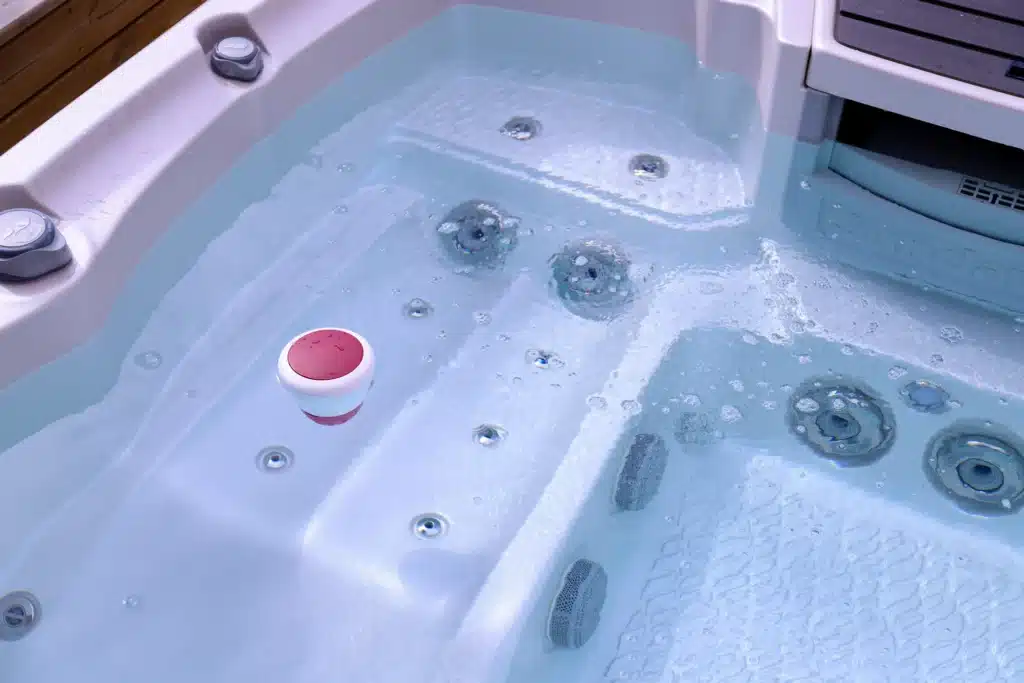A spa's water filtration system is essential for maintaining clear, healthy water, especially as warm water encourages the proliferation of bacteria. If you weren't convinced, you should know that good filtration contributes 80% to the health of your spa water! Which filtration system or filter should you use for your spa? How long should you filter your water? Find out all our tips in this article to help you maintain your spa.

Activating your spa's filtration system allows the water to be finely cleaned of impurities, especially as the spa is a particularly favorable environment for the development of microbes. In the filtration circuit, the water passes through filters before circulating through a heater and then being re-injected into the spa tank via the main nozzles. There are several filtration systems suitable for spas:
As the name suggests, this system activates filtration continuously, 24 hours a day. This system requires a pump equipped with an antibacterial filter, which is independent of the massage water circuit. Suitable for all types of spas, this system requires a slightly higher initial investment than other filters, but is nevertheless more economical as it limits the use of disinfectants.
This technique involves fitting a pre-filter to the filling pipe, so that the water entering the spa is already filtered. This extends the life of the cartridge filter that completes the system.
It takes place in a technical room and requires, as for a swimming pool, the installation of a piping system to the room. This system is recommended for built-in or overflow spas.
This technique works in cycles: water is injected into the pump and sent to the filter before returning to the spa. This system is quite effective at filtering water finely, but still requires a fair amount of energy (watch out for electricity bills).
This is the most basic and economical system: the skimmer is fitted with a pre-filter and a special filter sock. To be effective, however, this technique requires rigorous cleaning after every swim.
Filtering water is one of the recommended maintenance steps for a spa because it helps maintain its balance. There are several types of filter, whose efficiency is measured in microns, which corresponds to the fineness of filtration. Many manufacturers pre-equip their spas with a filtration system. However, it is possible to modify the filter type if you want a system that is more compatible with your needs.

This is the model most commonly used for spas, as it offers fairly fine water filtration (10 to 15 microns). For weekly maintenance, use a jet of water and a soft brush to remove dirt. You can also leave it to soak in a mixture of water and special filter cartridge cleaner in high season. This is the most economical system (between 35 and 80 euros per filter, depending on the model).
Mainly used for spas with a large volume of water, sand filters are ideal for swim spas or spas that are used very frequently, as filtration is fast. However, it requires the installation of a technical room, as the water is evacuated via a pump into a rather large tank, before being filtered by the sand (filtration of impurities and deposits of 30 to 50 microns, depending on the model). The addition of flocculant optimizes filtration finesse. Sand filters require regular maintenance: a backwash during weekly maintenance to remove sand residues. Special chemical filter cleaning twice a year removes limescale. Finally, the filter sand must be replaced every 3 years.
Zeolite is a volcanic rock added to sand (recommended mix: 60% zeolite to 100% sand). More environmentally friendly than other filter media, zeolite is winning over many consumers. In particular, it reduces the need for chemical products (disinfectants, anti-algae agents), delivers high filtration finesse and requires very little maintenance (cleaning with water once a week). Finally, it's a fairly economical solution. Simply rinse the rock with clean water before adding it to the sand to avoid dust particles. Zeolite is replaced every 7 to 10 years.
A diatomaceous earth powder is poured into a tank. This is the most precise model in terms of filtration fineness (5 microns). The diatomaceous earth filter represents a higher initial investment than other systems, as the powder must be regularly renewed and a sewer connection installed for discharge. This system requires a certain amount of technical expertise (filter pump flow rate, regular backwash, replacement of the filter membrane) and higher installation and maintenance costs (anti-rejection tank). Approx. 1000 euros for a filter (to be changed once a year) and installation of an anti-rejection tank.
Daily filtration is necessary to ensure healthy, balanced water. However, the length of time a spa needs to be filtered depends on a number of parameters: the quality of the equipment, the frequency of bathing (the more the water is exposed to pollution, the more it needs to be filtered), the volume of water in the pool and the water temperature. On average, spa water needs to be filtered 8 hours a day.
Continuous filtration is most often recommended for spas, as it limits the risk of cloudy water. Finally, it is not necessarily more energy-intensive (or less economical) than cycle filtration, because it is slower.
To find out the filtration time per cycle, calculate the time required for a complete water filtration cycle to find out the filtration time.
Turning on your spa's filtration just after adding a chemical product stimulates its diffusion more widely and activates its effect more quickly. This is generally part of the manufacturer's instructions for use.
Various systems are available on the market that allow you to analyze the quality of your spa water on a continuous basis. ICO Spa analysis pH, ORP, TDS and water temperature and sends recommendations on filtration times and chemical treatments to your smartphone.

Good filtration is essential for maintaining clear, healthy water. It also helps improve the performance of chemical treatments. It's important to choose the system best suited to your spa and your needs. Ask a professional for advice and refer to the manufacturer's recommendations.